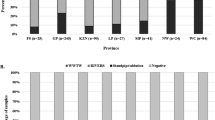Abstract
Enteroparasites in children from three marginal urban districts of Trujillo (Peru) were studied to treat these children and to design a prevention and control programme. A total of 845 children were examined. The general prevalence of enteroparasites was of 66.3%, and 45.6% were multiparasitized. The pathogenic enteroparasite prevalence were 23.8% (Giardia lamblia), 4.6% (Iodamoeba buschlii), 2.6% (Cyclospora cayetanensis), 2.2% (Hymenolepis nana), and 2% (Cryptosporidium spp.). G. lamblia was the most frequent parasite both in diarrheic children (28.1%) as well as in nondiarrheic ones (19.5%). The G. lamblia genotypes were molecularly characterized by sequence analysis of the glutamate dehydrogenase (gdh) gene using PCR and RFLP. Sequence analysis revealed both Assemblage A (AI and AII) and Assemblage B (BIV), with the predominance of Assemblage AI. All the samples with Assemblage A were diarrheic but not those with Assemblage B. This is the first study of molecular characterization of G. lamblia in Peruvian children and confirms the importance of asymptomatic patients in the transmission of the giardiosis, especially in places with poor hygiene and sanitation.


Similar content being viewed by others
References
Adam R (2001) Biology of Giardia lamblia. Clin Microbiol Rev 14:447–475
Astiazaran H, Espinosa M, Castanon G, Chavez-Munguia G, Martínez-Palomo A (2000) Giardia lamblia: effect of infection with symptomatic and asiymptomatic isolates on the growth of gerbils (Meriones unguiculatus). Exp Parasitol 95:128–135
Berkman DS, Lescano AG, Gilman RH, Lopez LS, Black MM (2002) Effects of stunting, diarrhoeal disease, and parasitic infection during infancy oncognition in late childhood: a folow-up study. Lancet 358:564–571
CDC (1995) Division of Parasitic Diseases Program Review. National Center for Infectious Diseases, Centers for Disease Control, Atlanta, G.A. USA, S.C
Cordova O, Vargas F, Gonzalez A, Peréz Cordón G, Velasco JR, Sánchez-Moreno M, Rodríguez Gonzalez I, Rosales MJ (2006) Intestinal parasitism in Peruvian children and molecular characterization of Cryptosporidium species. Parasitol Res 98:576–581
Gilman RH, Marquis GS, Miranda E, Vestegui M, Martinez H (1988) Rapid reinfection by Giardia lamblia after treatment in a hyperendemic Third World community. Lancet 13:343–345
Gonzales-Mugaburu L (1956) Encuesta de parásitos intestinales en 615 escolares del Rímac. Rev Peru Med Exp Salud Pública 10:2
Haque R, Roy S, Kabir M, Stroup SE, Mondal D, Houpt ER (2005) Giardia assemblage A infection and diarrhea in Bangladesh. J Infect Dis 192:2171–2173
Iannacone J, Benites MJ, Chirinos L (2006) Prevalencia de infección por parásitos intestinales en escolares de primaria de Santiago de Surco, Lima, Perú. Parasitol Latinoam 61:54–62
Maco V, Marcos LA, Terashima A, Samalvides F, Gotuzzo E (2002) Distribution of entero-parasitic infections in the Peruvian highland: study carried out in six rural communities of the department of Puno, Peru. Rev Gastroenterol Peru 22:304–309
Monis PT, Thompson RC (2003) Cryptosporidium and Giardia-zoonoses: fact or fiction? Infect Genet Evol 3:233–244
Monis PT, Mayrhofer G, Andrews RH, Homan WL, Limper L, Ey PL (1996) Molecular genetic analysis of Giardia intestinalis isolates at the glutamate dehydrogenase locus. Parasitology 112:1–12
PAHO (1998) Situación de Salud de los Pueblos Indígenas de Perú of the Iniciativa de Salud de los Pueblos Indígenas de OPS. Washington, D.C. p 38
Read CM, Monis PT, Thompson RCA (2004) Discrimination of all genotypes of Giardia duodenalis at the glutamate dehydrogenase locus using PCR-RFLP. Infection, Genetics and Evolution 4:125–130
Savioli L, Bundy D, Tomkins A (1992) Intestinal parasitic infections: A soluble public health problem. Trans R Soc Trop Med Hyg 86:353–354
Sulaiman IM, Fayer R, Bern C, Gilman RH, Trour JM, Schantz PM, Das P, Lal A, Xiao L (2003) Triosephosphate somerase gene characterization and potential zoonotic transmission of Giardia duodenalis. Emerg Infect Dis 9:1444–1452
Thompson RCA (2000) Giardiasis as a re-emerging infectious disease and its zoonotic potential. Int J Parasitol 30:1259–1267
Thompson RCA (2004) The zoonotic significance and molecular epidemiology of Giardia and giardiasis. Vet Parasitol 126:15–35
Thompson RCA, Hopkins RM, Homan WL (2000) Nomenclature and genetic groupings of Giardia infecting mammals. Parasitol Today 16:210–213
Torres-Portugal M, Campos E (1960) Encuesta de parasitosis intestinal en niños de edad preescolar en la ciudad de Arequipa. Revista Peruana de Medicina Experimental y Salud Pública 13:1–2
Vargas F, Jara D, Castillo R (1987) Protozoarios y helmintos intestinales en pobladores de Trujillo, Perú. Rebiol 6:3–14
Volatao AC, Costa-Macedo LM, Haddad FSM, Brandao A, Peralta JM, Fernández O (2007) Genotyping of Giardia duodenalis from human and animal simples from Brazil using b-giardin gene: A phylogenetic analysis. Acta Tropica 102:10–19
WHO (1991) Basic laboratory methods in medical parasitology. World Health Organization, Geneva
WHO (1996) Fighting disease, fostering development. World Health Organization, Geneva
Acknowledgements
This work has received financial support from the Agencia Española de Cooperación Internacional (A/2385/05) and the Agencia Andaluza de Cooperación Internacional (AI29/04).
Author information
Authors and Affiliations
Corresponding author
Rights and permissions
About this article
Cite this article
Peréz Cordón, G., Cordova Paz Soldan, O., Vargas Vásquez, F. et al. Prevalence of enteroparasites and genotyping of Giardia lamblia in Peruvian children. Parasitol Res 103, 459–465 (2008). https://doi.org/10.1007/s00436-008-1007-3
Received:
Accepted:
Published:
Issue Date:
DOI: https://doi.org/10.1007/s00436-008-1007-3




